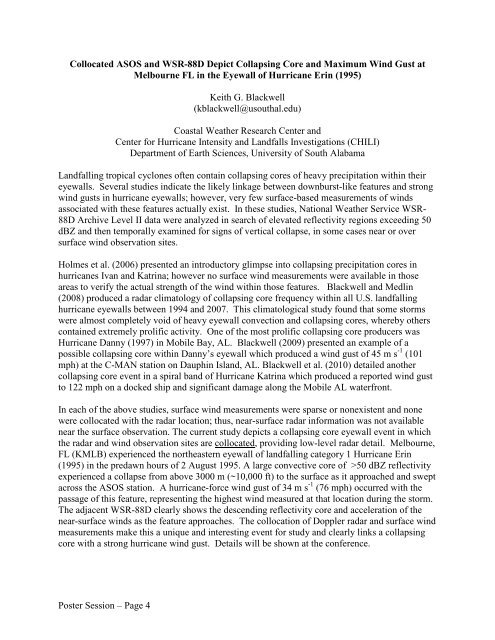65th IHC Booklet/Program (pdf - 4.9MB) - Office of the Federal ...
65th IHC Booklet/Program (pdf - 4.9MB) - Office of the Federal ...
65th IHC Booklet/Program (pdf - 4.9MB) - Office of the Federal ...
You also want an ePaper? Increase the reach of your titles
YUMPU automatically turns print PDFs into web optimized ePapers that Google loves.
Collocated ASOS and WSR-88D Depict Collapsing Core and Maximum Wind Gust at<br />
Melbourne FL in <strong>the</strong> Eyewall <strong>of</strong> Hurricane Erin (1995)<br />
Keith G. Blackwell<br />
(kblackwell@usouthal.edu)<br />
Coastal Wea<strong>the</strong>r Research Center and<br />
Center for Hurricane Intensity and Landfalls Investigations (CHILI)<br />
Department <strong>of</strong> Earth Sciences, University <strong>of</strong> South Alabama<br />
Landfalling tropical cyclones <strong>of</strong>ten contain collapsing cores <strong>of</strong> heavy precipitation within <strong>the</strong>ir<br />
eyewalls. Several studies indicate <strong>the</strong> likely linkage between downburst-like features and strong<br />
wind gusts in hurricane eyewalls; however, very few surface-based measurements <strong>of</strong> winds<br />
associated with <strong>the</strong>se features actually exist. In <strong>the</strong>se studies, National Wea<strong>the</strong>r Service WSR-<br />
88D Archive Level II data were analyzed in search <strong>of</strong> elevated reflectivity regions exceeding 50<br />
dBZ and <strong>the</strong>n temporally examined for signs <strong>of</strong> vertical collapse, in some cases near or over<br />
surface wind observation sites.<br />
Holmes et al. (2006) presented an introductory glimpse into collapsing precipitation cores in<br />
hurricanes Ivan and Katrina; however no surface wind measurements were available in those<br />
areas to verify <strong>the</strong> actual strength <strong>of</strong> <strong>the</strong> wind within those features. Blackwell and Medlin<br />
(2008) produced a radar climatology <strong>of</strong> collapsing core frequency within all U.S. landfalling<br />
hurricane eyewalls between 1994 and 2007. This climatological study found that some storms<br />
were almost completely void <strong>of</strong> heavy eyewall convection and collapsing cores, whereby o<strong>the</strong>rs<br />
contained extremely prolific activity. One <strong>of</strong> <strong>the</strong> most prolific collapsing core producers was<br />
Hurricane Danny (1997) in Mobile Bay, AL. Blackwell (2009) presented an example <strong>of</strong> a<br />
possible collapsing core within Danny’s eyewall which produced a wind gust <strong>of</strong> 45 m s -1 (101<br />
mph) at <strong>the</strong> C-MAN station on Dauphin Island, AL. Blackwell et al. (2010) detailed ano<strong>the</strong>r<br />
collapsing core event in a spiral band <strong>of</strong> Hurricane Katrina which produced a reported wind gust<br />
to 122 mph on a docked ship and significant damage along <strong>the</strong> Mobile AL waterfront.<br />
In each <strong>of</strong> <strong>the</strong> above studies, surface wind measurements were sparse or nonexistent and none<br />
were collocated with <strong>the</strong> radar location; thus, near-surface radar information was not available<br />
near <strong>the</strong> surface observation. The current study depicts a collapsing core eyewall event in which<br />
<strong>the</strong> radar and wind observation sites are collocated, providing low-level radar detail. Melbourne,<br />
FL (KMLB) experienced <strong>the</strong> nor<strong>the</strong>astern eyewall <strong>of</strong> landfalling category 1 Hurricane Erin<br />
(1995) in <strong>the</strong> predawn hours <strong>of</strong> 2 August 1995. A large convective core <strong>of</strong> >50 dBZ reflectivity<br />
experienced a collapse from above 3000 m (~10,000 ft) to <strong>the</strong> surface as it approached and swept<br />
across <strong>the</strong> ASOS station. A hurricane-force wind gust <strong>of</strong> 34 m s -1 (76 mph) occurred with <strong>the</strong><br />
passage <strong>of</strong> this feature, representing <strong>the</strong> highest wind measured at that location during <strong>the</strong> storm.<br />
The adjacent WSR-88D clearly shows <strong>the</strong> descending reflectivity core and acceleration <strong>of</strong> <strong>the</strong><br />
near-surface winds as <strong>the</strong> feature approaches. The collocation <strong>of</strong> Doppler radar and surface wind<br />
measurements make this a unique and interesting event for study and clearly links a collapsing<br />
core with a strong hurricane wind gust. Details will be shown at <strong>the</strong> conference.<br />
Poster Session – Page 4
















